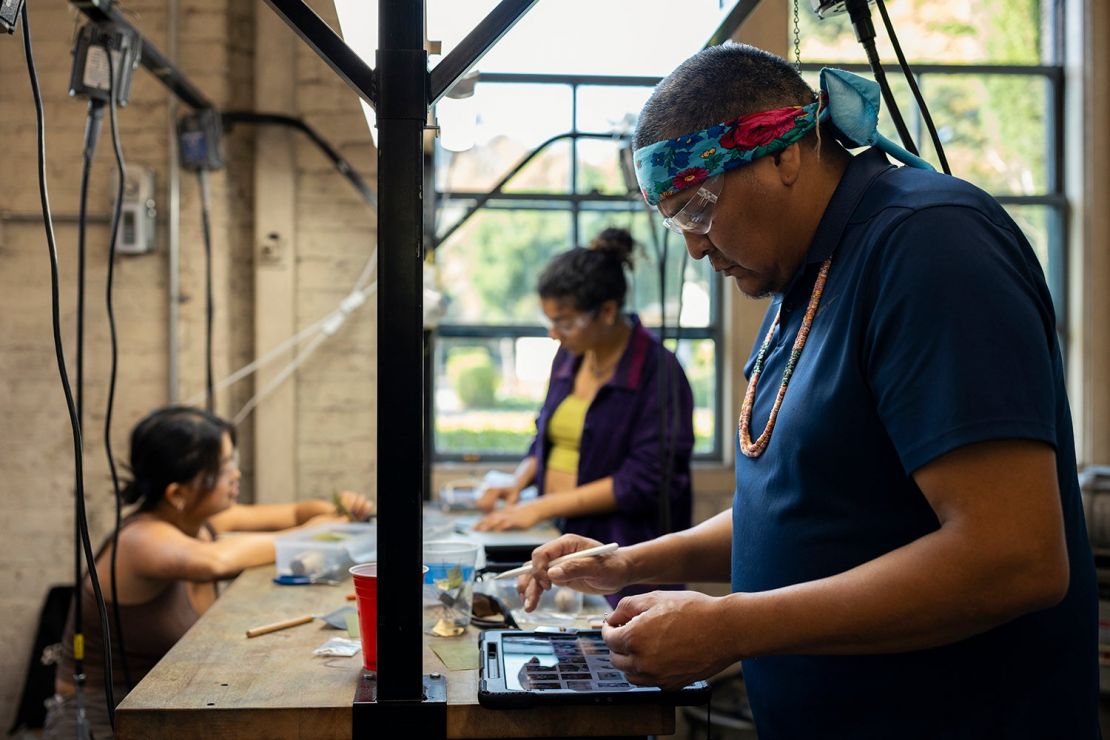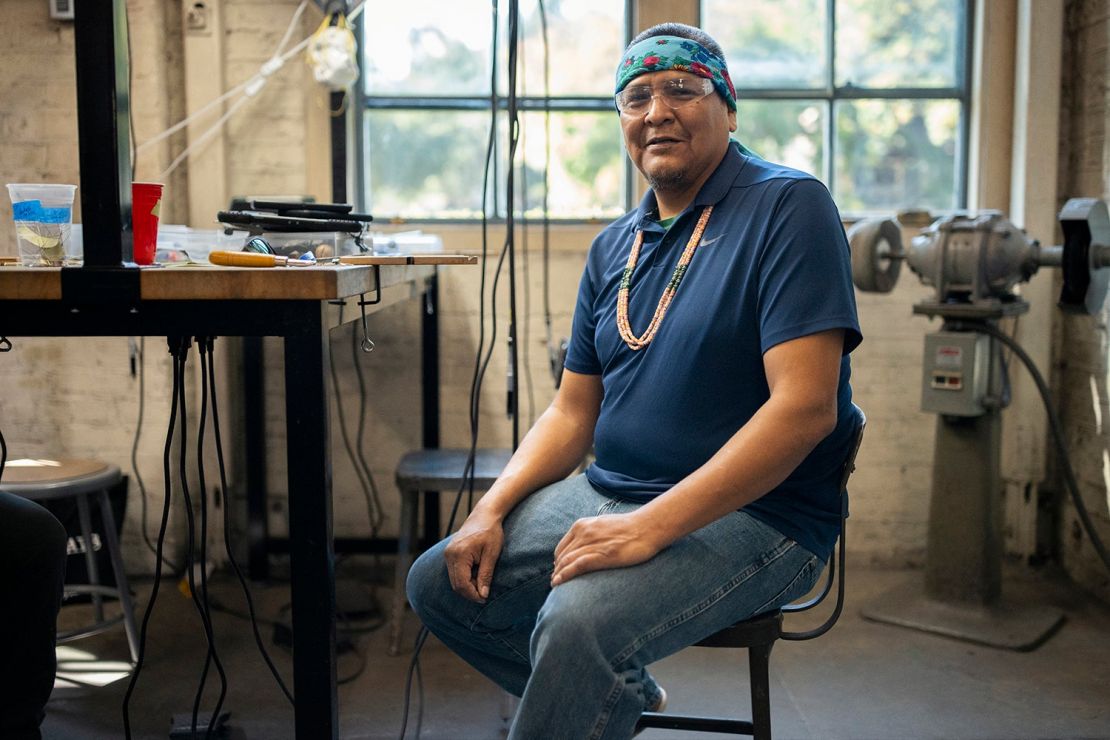
Robert Blackhat Jr. is one of two visiting Navajo artists who worked with students in the Art Intensive class. (Image credit: Andrew Brodhead)
Over two days in September, visiting Navajo artists worked alongside Stanford students as they finished their silver jewelry projects – twisting wire to create delicate filigree, soldering the filigree to cast pieces, setting cabochon gemstones in bezels, and more.

Students received guidance on techniques such as twisting wire to create filigree. (Image credit: Andrew Brodhead)
Artists Zefren Anderson and Robert Blackhat Jr. visited the jewelry design class as part of the 13-day Arts Intensive course, which occurs annually before the onset of the academic year.

Navajo artists Robert Blackhat Jr. and Zefren Anderson visited the Arts Intensive class. (Image credit: Andrew Brodhead)
Arts Intensive offers students time to focus on a single, project-based, hands-on arts class featuring guest artists to encourage curiosity and creative skill-building. The three-week program held each September is open to rising sophomores, juniors, and seniors – regardless of artistic training or experience. “Stanford students are intense and ambitious by nature, but Arts Intensive provides a different kind of intensity,” said Amanda Knox Sather, a lecturer appointed through the Department of Mechanical Engineering and Arts Intensive. “It’s a very fun, unusual experience. I feel like it frees students up to make it just a bit more of a personal journey, and they can make it what they want.”
Sather and Sara Shaughnessy, also a lecturer appointed through the Department of Mechanical Engineering and Arts Intensive, teach the bronze and silver jewelry design course at the Stanford Product Realization Lab (PRL), a multi-site teaching facility. In a red-brick building with tall paned windows at the corner of Santa Teresa and Duena streets, students shared a communal workspace, tool sets, ideas, and techniques.
Students sometimes feel intimidated by the arts, but jewelry – a personal adornment – can serve as a more accessible way to enter the field, Sather said. “It provides a unique opportunity for people to immediately be personally invested in the design and get away from the hurdles of intimidation.”

Visiting artists provided Arts Intensive students with guidance on their silver jewelry projects. (Image credit: Andrew Brodhead)
By the time Anderson and Blackhat Jr. arrived, the 15 students in the class were midway through their projects and could work alongside the artists to complete them. The artists quickly settled into a comfortable rhythm working with the students – reviewing designs, providing feedback, answering questions, and demonstrating techniques that combined cutting-edge technology with ones that have been honed over thousands of years. Blackhat Jr.’s mother “journeyed on into the spirit world” when he was 10, he said, and before she passed, she taught him silversmithing, which she had learned from her father. It was these techniques, passed down through generations, that Blackhat Jr. shared with students during the visit.

Robert Blackhat Jr. is one of two visiting Navajo artists who spent two and a half days with undergraduate students in the Arts Intensive course this September. (Image credit: Andrew Brodhead)
Blackhat Jr. marked the end of the visit with an offering to the ocean, and more than half of the students joined him at Pomponio Beach, where he explained details of the offering and the sacredness of the site. “Through eloquent instruction, my purpose was to impart knowledge from a different perspective, which helps enrich the students’ understanding and helps them develop their own abilities,” Blackhat Jr. said. “Hopefully, I have helped foster a sense of enlightenment and cultivate the intellectual growth of aspiring young individuals while guiding them towards pristine craftsmanship.”

Robert Blackhat Jr. poses for a photo while visiting with students in September. (Image credit: Andrew Brodhead)
The visit was years in the making. Heather Fleming, BA ’03, is co-founder and executive director of Change Labs, an organization supporting entrepreneurship and innovation in the Navajo Nation. In 2019, Fleming sent an email to design alumni asking if any jewelers would come to the Navajo reservation for a workshop. Sather and Shaughnessy agreed to come, and in February 2020, they went to Tuba City, Arizona. There, they heard how long some of the artists drove to attend the one-day workshop – some as long as six hours roundtrip – and were excited by how committed the artists were to their work and incorporating new techniques alongside traditional ones. In 2022, Sather and Shaughnessy asked if Anderson and Blackhat Jr. would be interested in coming to visit the Arts Intensive course, and they agreed to do so.
Go to the web site to view the video.
“Anytime you find individuals who are committed to their craft with such passion but offer a different perspective, it is just tremendously valuable and enriching for the students,” Sather said. “And we’ve seen this in a microcosm, in terms of the many different majors that our classes appeal to.” Anderson added that despite changes in higher education over the years, students still use the hands-on creative cycle of planning, observation, and revision – an experience that helps build community across majors, cultures, and backgrounds.
The experience reminded Anderson to continue his own education to broaden his understanding of human culture and art, and become a better instructor. “I want to create more learning experiences that leave students with an intense feeling of hope, satisfaction, and altruism,” he said. “The creative cycle of thought, planning, creating, and revising jewelry fabrication follows the core philosophy of Navajo culture. Only successful ideas proven over time are integrated into broader cultural practice. The acceptance of failure in order to start a better plan builds better community knowledge. The students learned this while building an understanding of human nature, ethics, and reasoning, along with a healthy dose of skepticism, that will serve them well for the rest of their careers.”

Artist Zefren Anderson guides students as they complete their silver jewelry projects. (Image credit: Andrew Brodhead)
Sather said she also looks forward to seeing how collaborations like this could benefit visiting artists as they share new tools and techniques that may not be within easy reach to the average artist. Students interested in applying to Arts Intensive, as well as faculty interested in teaching courses in the program, can find more information here.
“It’s a unique learning experience,” Sather said. “It affords a sort of quick window of an experience and a chance to create in the last gasp of summer.”

Artists Robert Blackhat Jr. and Zefren Anderson pose for a photo with Arts Intensive students and instructors during their two-day visit in September. (Image credit: Andrew Brodhead)



